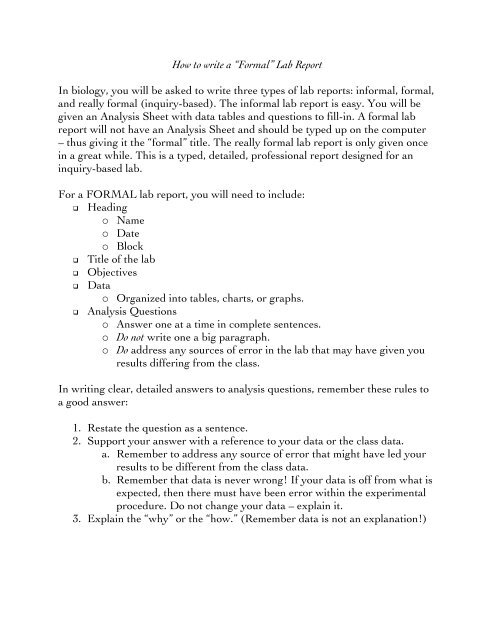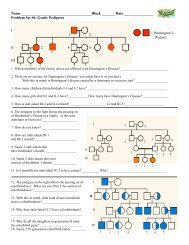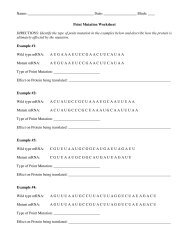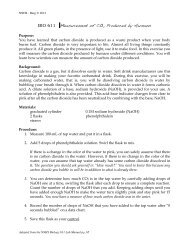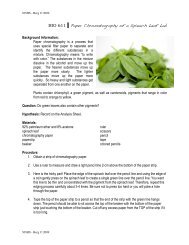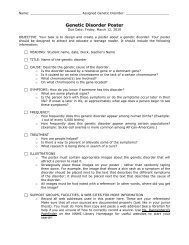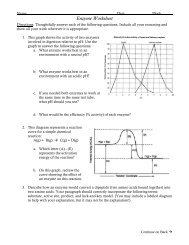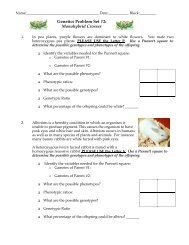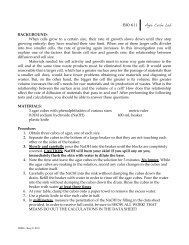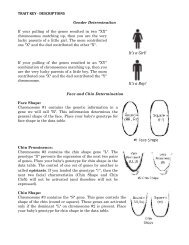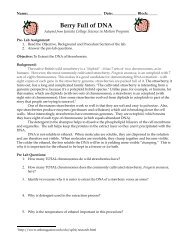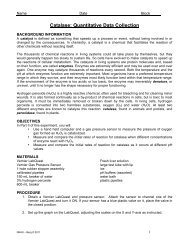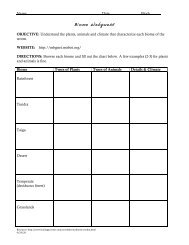How to write a “Formal” Lab Report In biology, you ... - nnhsbergbio
How to write a “Formal” Lab Report In biology, you ... - nnhsbergbio
How to write a “Formal” Lab Report In biology, you ... - nnhsbergbio
You also want an ePaper? Increase the reach of your titles
YUMPU automatically turns print PDFs into web optimized ePapers that Google loves.
<strong>How</strong> <strong>to</strong> <strong>write</strong> a <strong>“Formal”</strong> <strong>Lab</strong> <strong>Report</strong><br />
<strong>In</strong> <strong>biology</strong>, <strong>you</strong> will be asked <strong>to</strong> <strong>write</strong> three types of lab reports: informal, formal,<br />
and really formal (inquiry-based). The informal lab report is easy. You will be<br />
given an Analysis Sheet with data tables and questions <strong>to</strong> fill-in. A formal lab<br />
report will not have an Analysis Sheet and should be typed up on the computer<br />
– thus giving it the “formal” title. The really formal lab report is only given once<br />
in a great while. This is a typed, detailed, professional report designed for an<br />
inquiry-based lab.<br />
For a FORMAL lab report, <strong>you</strong> will need <strong>to</strong> include:<br />
Heading<br />
o Name<br />
o Date<br />
o Block<br />
Title of the lab<br />
Objectives<br />
Data<br />
o Organized in<strong>to</strong> tables, charts, or graphs.<br />
Analysis Questions<br />
o Answer one at a time in complete sentences.<br />
o Do not <strong>write</strong> one a big paragraph.<br />
o Do address any sources of error in the lab that may have given <strong>you</strong><br />
results differing from the class.<br />
<strong>In</strong> writing clear, detailed answers <strong>to</strong> analysis questions, remember these rules <strong>to</strong><br />
a good answer:<br />
1. Restate the question as a sentence.<br />
2. Support <strong>you</strong>r answer with a reference <strong>to</strong> <strong>you</strong>r data or the class data.<br />
a. Remember <strong>to</strong> address any source of error that might have led <strong>you</strong>r<br />
results <strong>to</strong> be different from the class data.<br />
b. Remember that data is never wrong! If <strong>you</strong>r data is off from what is<br />
expected, then there must have been error within the experimental<br />
procedure. Do not change <strong>you</strong>r data – explain it.<br />
3. Explain the “why” or the “how.” (Remember data is not an explanation!)
Sample Answers <strong>to</strong> Worm <strong>Lab</strong><br />
Data Table<br />
Percent Seawater Weight (g) Pulse (bpm) Observations of Behavior<br />
100 2.78 14 Swimming around the bowl; rolling over on its back and<br />
then flipping around; no pinchers showing; turning<br />
around when poked with a pencil; quick movement<br />
75 3.4 13 Squirming a lot when first placed in new solution, then<br />
slowing down; no pinchers showing; still moving quite a<br />
bit; responds <strong>to</strong> a poke with a pencil.<br />
50 3.56 11 Not happy when placed in new solution; showing its<br />
pinchers; movement starts <strong>to</strong> slow down; its response<br />
time <strong>to</strong> pencil is very poor<br />
25 4.1 7 Pinchers showing more than once; mouth opening and<br />
closing; lifting head out of water; slower movements;<br />
stretching out its body and not curling up; no longer<br />
responding <strong>to</strong> a gentle poke by a pencil<br />
0 5.6 4 Pincers out; stretched out; no response <strong>to</strong> poke, looks<br />
dead; no voluntary movement<br />
Class Data; generally the same as my group’s data shown above<br />
Question: What is the relationship between the percent seawater and the<br />
worm’s pulse. Give a reason for this relationship.<br />
Very Poor Answer: “As one goes up, the other goes down. Its pulse goes down<br />
because it started at 14 and ended at 4.”<br />
What is wrong with this answer<br />
Does not restate the question as a statement.<br />
Uses pronouns without identifying what they are in the beginning.<br />
What is “one”, the “other”, or “its”<br />
Confuses the data as a reason or an explanation.<br />
Does not use units for the quantitative data.<br />
Very Good Answer: “As the percent seawater decreased, the worm’s pulse also<br />
decreased as shown by an overall drop from 14 bpm <strong>to</strong> only 4 bpm at the end<br />
(See Data Table). One possible reason for the decrease in pulse is the fact that<br />
the worm is under stress in its new environment. <strong>In</strong> order <strong>to</strong> maintain<br />
homeostasis, the worm lowers its pulse and becomes less active <strong>to</strong> reserve its<br />
energy.”<br />
What is right with this answer<br />
Everything. (See tips from previous page.)


